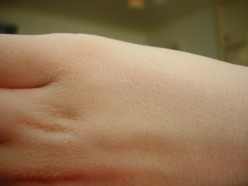The sun can do a number on the elasticity of one's skin, causing some serious wrinkling over time. However, a network of scientists have developed a product described as a "second skin" that can reverse some of that damage.
The substance is silicone-based polymer can be applied as a thin coating on the skin. It mimics the elastic and mechanical properties of young, healthy skin.
During human trials, it was able to reshape under eye bags and improve skin hypdration.
While the creation has beauty applications, researchers from MIT, Massachusetts General Hospital (MGH), Olivo Labs and Jennifer Aniston's beauty company Living Proof found that that in addition to tightening, and smoothing the skin, it can also protect the skin from harmful UV rays and possibly be used to provide medication for skin problems like eczema and dermatitis, according to research published in Nature Materials.
“It’s an invisible layer that can provide a barrier, provide cosmetic improvement, and potentially deliver a drug locally to the area that’s being treated. Those three things together could really make it ideal for use in humans,” study author Daniel Anderson said.
Anderson is an associate professor in MIT’s Department of Chemical Engineering and a member of MIT’s Koch Institute for Integrative Cancer Research and Institute for Medical Engineering and Science (IMES).
The development of the product has spanned a decade, with over 100 possible polymers that were created before making one flexible and compatible enough to mimic real skin. What gives the product its power is the cross-linked polymer layer, or XPL.
The XPL developed could be stretched more than 250 percent and still return to its original state, unlike natural skin, which can only be stretched 180 percent and maintain its elasticity.
XPL also outpreformed elasticity outperformed silicone gel sheets and polyurethane films which are used as wound dressings.
Scientists conducted multiple studies to test the XPL’s safety and effectiveness. In one study, they found the material helped tighten under-eye bags for 24 hours, and in another, they found the material helped prevent water loss from skin better than high-end commercial moisturizer 24 hours after application. None of the study participants reported irritation from wearing the XPL.
“I think it has great potential for both cosmetic and noncosmetic applications, especially if you could incorporate antimicrobial agents or medications,” Thahn Nga Tran, a dermatologist and instructor at Harvard Medical School, who was not involved in the research, said in the release.

